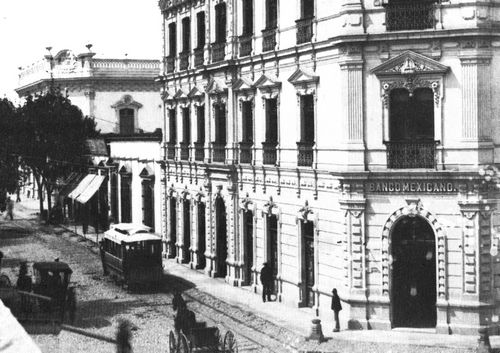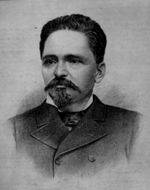The Banco Mexicano
Luis Terrazas began to extend his interests into banking in 1878. On 8 March the Chihuahuan government, then headed by Angel Trias, gave Terrazas, Félix Francisco Maceyra and Antonio Asúnsolo permission to establish a bank of issue under the presumptuous name El Banco Mexicano.
The bank could issue up to 300,000 pesos in twenty-five centavos, fifty centavos and one peso notes, payable in legal tender or in hard cash at an 8% discount (en moneda corriente ó en pesos fuertes al 8 por ciento de cambio). The bank was given eight months to establish itself or the concession would lapsePeriódico Oficial, 10 March 1878. The bank also had to satisfy the government that its issue was backed by mortgages on property, though this proviso was probably more a sign of growing refinement in drafting legislation than that this was the first concession granted to native Mexicans. Later legislation, on 31 July 1882, inter alia, enabled the state government to appoint interventors for the bankPeriódico Oficial, 12 August 1882.
Terrazas had yet to establish his pre-eminence in Chihuahua and Maceyra and Asúnsolo, his partners in this venture, were wealthy landowners in their own right. All three had been assessed at $2,000 in Trias’ forced loan of 1876Boletín Militar, 1 July 1876 and the last two were associates in the business firm of Asúnsolo y MaceyraLa República, 28 August 1868. In 1879 the principal shareholders were Félix Francisco Maceyra, Luis Terrazas, Luis Faudoa, Miguel Salas and Ramón Luján. By 1881 the bank was advertising that it bought ‘cattle hides, copper, lead, cotton, sugarcane’ and made advances on these itemsBoletín Militar, 1 January 1881 indicating that in the beginning these banks were not just concerned with financial transactions but also acted as brokers and commodity dealers.
The bank was also connected with the Chihuahua mint. In 1879 a group of businessmen who were the main shareholders of the Banco Mexicano, through their solicitor Gustavo Sommer, sought for the decree banning the lease of mints to be revoked. As soon as the government gave its assent the shareholders negotiated a lease for five years of the mint in Chihuahua. The lease was dated 30 December 1879 and obtained Presidential approval on 5 January 1880. The contract was extended on 12 July 1883 for six years and again on 4 February 1888. It was rescinded on 21 February 1895AP papers, Box 3:1 “Historia Numismática de Chihuahua”.
On 23 March 1886 the Secretario de Hacienda, Manuel Dublán, signed an agreement with Carlos Pacheco, representing the banks of Chihuahua, José del Collado, a director of the Banco Nacional de México, and Ramón Uzandizaga, manager of the Chihuahua branch. In it they recognized that the Chihuahuan banks had been established by concessions from the state Congress, at a time when federal control was unclear, and so the Secretaría de Hacienda confirmed the Banco Mexicano’s concession for a further 25 years, and that it could issue up to $100,000 in notes of various denominations payable in copper at par or in silver at a 8% discount or at par in hard currency (pagaderos en cobre a la par o en plata con 8% de descuento o pagaderos a la par en pesos fuertes)AHBanamex, Actas del Consejo de Administración, 23 March 1886, folios 246-250.
Offices
The bank's offices were originally the premises used by Félix Francisco Maceyra at [ ] and in 1881 were at the corner of Independencia and Victoria.
National Bank Note Company notes
The bank's earliest notes (with the legend ‘Banco Mejicano’) were dated 1878. They were ordered by Ramón Luján and printed by the National Bank Note CompanySome people saw the formation of the American Bank Note Company in 1858 as a threat, because a firm formed by the merger of seven companies suggested monopoly. Four principal employees of Danforth, Perkins and Company, one of the seven companies, resigned over the terms of the merger. These four, two employees from its earlier firm (Danforth, Wright and Company), and three bankers organised the National Bank Note Company in 1859.The company faced fierce competition from the American Bank Note Company and finally capitulated to a consolidation with Continental Bank Note Company and American Bank Note Company in 1879 in September 1878.
The print run was:
| Date | Value | Number | Series | from | to |
|---|---|---|---|---|---|
| September 1878 | 25c | 0001 | 200000 | ||
| 50c | 0001 | 150000 | |||
| $1c | 0001 | 175000 |
These early 25c has small serial numbers. Most of the 50c have a brown seal as part of the background but some have an orange seal . This might have been a production change (between [133734?] and 133810) but more likely was a chemical reaction. On later occasions banks complained to the ABNC that their notes had changed colour. Thus, in July 1907 the Banco de Durango sent an example of their $10 notes that had changed colour. The ABNC replied “If you will carefully examine one of these ten dollar notes, you will notice that the Orange tint which is spread over all of the face, has a distinct pattern, although same is not very apparent. This orange tint is put on with the idea of security against counterfeiting by photography, and the note which you sent us proves its efficacy. Some one, evidently with the idea of obliterating this protective tint, so that they would be able to secure a clear photographic reproduction of the black work, has subjected the note to a bath of – say sulpher, but has only succeeded in changing the color from Orange to Black, which brings out much more distinctly the [ ]oid pattern of the tint. The same chemical action has taken place with the orange back, changing the color to the brown as it now appears.”ABNC, folder 169, Banco de Durango 1906-1931). Then, in January 1909, the Banco Occidental de México sent three $5 notes. “Two of them as you can see, are not on their original color, as you can note it very clear by the third one that we sent you enclosed for that purpose, and as we are afraid that there might be a falsification, we would be very much obliged to you if you kindly examine them very carefully and report us if the change on colors could be caused by some acid effect, or on printing them, or what is your valued opinion regarding to this matter.”. Again, the ABNC replied that the note “has been subjected to the action of sulphur, either intentionally, with a view to more easily screening out the colors and thus being able to photograph the key plate, or unintentionally, as for instance, through having it in one’s possession while on a visit to sulpher springs, or placing it with sulphur matches in one’s pocket, etc.”ABNC, folder 1055 Banco Occidental de México (1909-1931). Though the ABNC's processes might have been more sophisticated, it is obvious the a orange/brown colour shift was a possible outcome.
The $1 note was printed in sheets of twelve notes with the range of series letters A-L thus:
| A | B |
| C | D |
| E | F |
| G | H |
| I | J |
| K | L |
and the notes were numbered sequentially in columns before the sheets were cut, thus Series A was 1, 13, 25, 37…, Series C 2, 14, 26, 38…, Series B 7, 19, 31, 43… and so onIn total, one 25c face plate, one 25c back plate and one 25c tint plate (with 21 notes on each); one 50c face plate, one 50c back plate and one 50c tint plate (with 21 notes on each); and one $1 face plate, one $1 back plate and one $1c tint plate (with 12 notes on each, were made on an order (Nat. #7711) on 10 September 1878. These were cancelled on 14 March 1932 (ABNC)..
Signatories
The signatories are Félix Francisco Maceyra as President and Ramón Luján as Accountant (Contador).
|
He opposed the French and was jefe político of the district of Iturbide in 1868-1869 and of Chihuahua in 1872. He moved his business from Jesús María to Chihuahua after trouble with the French and in 1880 he was one of the founding shareholders of the bank and as manager in May 1881 inaugurated the first telephone line in the city between the bank and the mint (Casa de Moneda). He was a deputy to the state legislature in 1873-1877 and 1885-1887, substitute governor from June 1885 to July 1887 and afterwards represented the state of Guerrero in the Senate for three terms (1888-1897). He died on 28 December 1897. |
 |
|
José Ramón Remigio Luján Estavillo was born in Chihuahua, Chihuahua in 1832. He was the owner of the Corralitos mines, a state deputy, and jefe político of Galeana. He was a large shareholder in the Compañía Industrial Jabonera de la Laguna. He appears as contador on the Banco Mejicano notes and later as cashier (cajero) of the Banco Mexicano from September 1888 until December 1890 and again between May 1893 and December 1895. He died in 1899. |
 |


